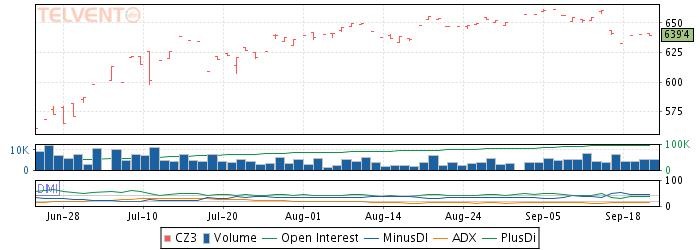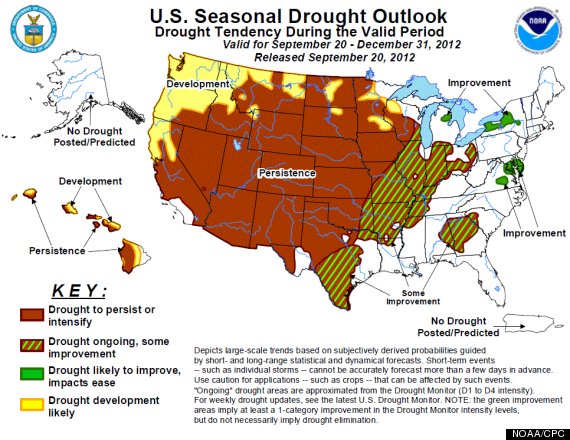I) What went right?
II) Road Ahead
III) Cool Source of information
i) What went right?
Initially, I decided to long for the December corn futures contract in anticipation that the drought in the United States would be highly detrimental to the corn harvest across farms such as in Kentucky, West Texas, South Carolina, etc. In particular, this year’s drought has created a deviation beyond the normal pattern in which rain fall does not resume earlier in this September. It turns out that, according to the latest report from the US Drought Monitor in the US edition of Huffington Post Canada, forecasts have indicated that “drought may persist through early winter, and are projected to develop further through Pacific Northwest and Upper Midwest.”
In addition, according to the news source McCathy Tribune Information Services (Sept 13), james Cromer, the Kentucky Commissioner of agriculture, remarked that farmers suffered from massive losses in corn yields, which resulted in food shortage for cattles and soaring prices at grocery stores and gas pumps. In particular, Green Bowling farm suffered from a hard hit as one of the major corn producers.
I thought this approach was reasonable, since drought drives down supply for corn which in turn results in rising costs for cattle-feed, and thus, demand for cattle-feed reduces the availability of corn supply for human consumption. As supply of corn commodity shifts left, price for corn is higher for every quantity level. Consequently, corn becomes more expensive, and thus, this implies potential profits for buying the corn futures contract in December.
However, I failed to take into account the possibility of improved situations in some regions in the United States which contributed to substantive amounts of harvest yields. In effect, higher yield regions such as areas between South Texas, Indiana, and parts of Ohio (potentially Alabama, Georgia and South Carolina) could possibly have some improvement in drought conditions which helped outweigh losses in harvest from regions with severe droughts.
Lesson learned: exit earlier on Sept 14th from the market by selling the corn futures contract in December to reduce my losses of $988.50.
Road Ahead
Once dry season ends, rain fall does return gradually in September as the normal pattern resumes. This implies that corn harvest becomes more abundant, and thus, prices become lower when farmers have more supply of corn available in the market. However, I do need to take into account that storage is an important price-controlling factor, as it enables farmers to reduce the rate of decrease in corn prices (in effort to maximize profitability by adjusting market supply).
However, there are numerous inconsistencies in the outcome of corn harvest depending on variations in regional rainfall patterns, soil quality, allocations of corn harvest to production of ready-to-feed corn silage.
In my point of view, I anticipate that the drought-stress results in a decrease quality of production for ready-to-feed corn silage due to a lack of moisture for good preservation and storage. In addition, there are more uncertainties associated with how well farmers ferment their corn feed, and the risk levels of buying corn-stand versus corn silage.
Within the next few weeks, since there has been ecoli-infection detected in Canadian beef sourced from the Edmonton-based XL foods, I anticipate a decrease in demand for beef in the market as consumers become increasingly cautious about beef consumption. This adverse demand shock induces farmers to reduce their supply of beef in the market which implies that they reduce their purchase on cattle-meals from corn.
In addition, when we examine the potential consequence of el Niño effect which may profoundly alter the weather pattern by introducing more humidity into the South and the Ohio Valley. However, according to the NOAA climate prediction centre, forecaster High Van Dan Dool claimed, “the effect this year would more likely to be modest, since water temperatures halted their increase during September. In effect, this may prevent a strong El Niño event from occurring. We expect this will intensify a little bit as we get into later fall, but it is probably too late to get a major El Niño.”
Consequently, based on these two causes, the availability of corn consumption for humans will increase, which will, in turn, drive down prices of corn. Therefore, if I were to invest in corn futures again, I would choose to short for corn.
iii) Cool sources of information and references
By far, My favourite article is called “Farmers looking at widely varying yields.” This article is sourced from the Tribune Info Services viz ComTex. Jim Luzar of Vigo County, the theme from “Drought of 2012” predicts the variability in corn yields at Wabash Valley in Illanois and Indiana.
There is data indicating that 70 of the farmers from the south of interstate reported with 15 bushels of corn per acre in some spots but in others up to 140.
In addition, there are variations in amount rainfall. For instance, white City (East of city of Regina) received significantly more rainfall than Vigo.
According to Luzar, the summer drought situation has been worse than the 1988 drought in some aspects. At least, there were 2-3 inches of rain in July ’88 which helped alleviate the dire situation.
In effect, severe drought results in high temperateure and a lack of moisture as more swaths of corn were plowed and harvested for cattle-feed.
My second favoruite was the article from Wisconsin University about the factors that affect pricing of corn silage. The author mentioned factors such as production costs, grain price, harvesting costs, handling and sotrage costs, orgnanic content of stover, quality of starch, and digestibility of the neutral detergent fiber.
Furthermore, the author looked at the perspective of a growers (sellers) who computed prices based on corn grain yield, and diarymen (buyers) who calculated based on availability alternative forages, namely alfalfa. Ultimately, market price is still determined by the invisible hand that comes forth with a price which equalizes supply and demand quantities.
References
“CFIA recalls ground beef product for the fifth time,” Canadian Press September 22nd, 2012. CTV, Bell Media.
http://www.ctvnews.ca/health/cfia-expands-recall-of-ground-beef-products-for-fifth-time-1.967466
“Corn Agronomy – Price Stressed Corn Silage,” July 10th, 2012.
http://wisccorn.blogspot.ca/2012/07/pricing-drought-stressed-corn.html
“Farmers overcome challenges as agriculture shifts” Sep 13, 2012 (Daily News – McClatchy-Tribune Information Services.
http://futures.tradingcharts.com/news/futures/Farmers_overcome_challenges_as_agriculture_shifts_185492065.html
“Pricing Corn Silage in 2012, Ontario – Ministry of Agriculture, Food, and Rural Affairs”
http://www.omafra.gov.on.ca/english/crops/field/forages/cornsilage2012.htm
“Pricing Drought Stressed Corn Silage” Broad of regents of the university of Wisconsin system
http://fyi.uwex.edu/drought2012/tag/corn-silage/
“Pricing Drought-Stressed corn for Corn Silage”
http://web.extension.illinois.edu/oardc/downloads/43940.pdf
US Drought May Persist through Winter Through Early Winter Forecast Predicts” Huffington Post, Canada (The US. Edition) http://www.huffingtonpost.com/2012/09/21/us-drought-growth-2012-winter_n_1903478.html?utm_hp_ref=green


2 replies on “Analysis of Week I for corn futures contract (C3Z)”
Good analysis on the beef and corn relationship. Please include more detailed description on the calculation of your equity balance. Thanks!
Thanks, Yijeong. Next time, I will be posting the three topics along with the equity balance.